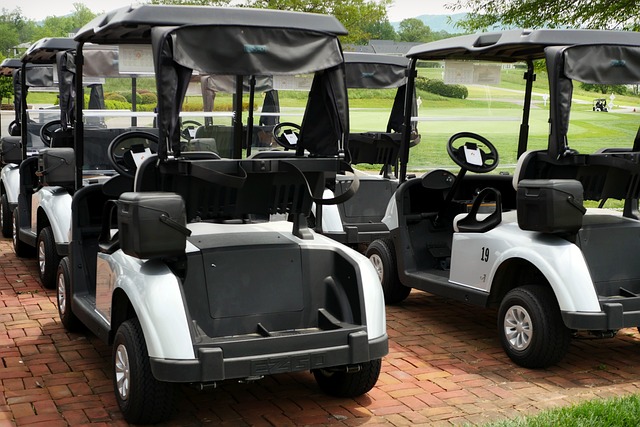Ez Go golf cart batteries require specialized care to maintain their longevity and optimal performance. For lead-acid batteries, monthly water level checks and terminal inspections are necessary to prevent overcharging and corrosion. Lithium battery systems, on the other hand, demand attention to state of charge and monitoring the battery management system for proper cell balance and protection against harmful charging conditions. Regular examinations of the BMS for error indicators and timely replacements are essential. Storing golf carts in temperature-controlled environments protects lithium batteries from extreme temperatures that can affect capacity. Proper care, including preventing sulfation by avoiding deep discharges and maintaining water levels with distilled or deionized water, is crucial for lead-acid batteries. Regular maintenance, such as terminal cleaning and inspecting connections, can prevent issues.
When Ez Go golf cart batteries show signs of weak performance, low voltage readings, or failure to hold a charge, prompt action is needed, including voltage checks, cleaning terminals, testing the alternator and voltage regulator, and replacing defective components. Charging practices should adhere strictly to manufacturer guidelines, with batteries fully depleting before recharging to avoid overcharging. Using the correct charger for the battery type is vital due to differing charging requirements. Regular upkeep, including cleaning battery cases and terminals, maintaining water levels, and storing batteries indoors during extreme weather, extends their lifespan. When performance declines significantly after five to seven years, or when carts consistently underperform, it's time for battery replacement. Considering the cost-to-use ratio and the benefits of advanced AGM or gel technology batteries can enhance your Ez Go golf cart experience with longer service life, quicker charging, and greater reliability.
Title: Mastering the Maintenance of Your Ez Go Golf Cart Battery System
When your Ez Go golf cart’s performance falters, it’s often a battery issue. This comprehensive guide demystifies the common problems associated with Ez Go golf cart batteries and provides practical solutions to get you back on the green seamlessly. From understanding the intricacies of your battery system to mastering recharge techniques, this article offers a step-by-step approach to troubleshooting and maintaining your Ez Go batteries for optimal performance. Learn the telltale signs that indicate it’s time for a replacement and discover maintenance tips that can extend your batteries’ lifespan, ensuring your cart remains reliable on every hole. With expert advice tailored specifically for Ez Go golf cart batteries, you’ll be well-equipped to handle any electrical challenges that arise.
- Understanding Your Ez Go Golf Cart Battery System
- Common Ez Go Golf Cart Battery Problems and Solutions
- Step-by-Step Guide to Troubleshooting Ez Go Golf Cart Batteries
- How to Recharge Your Ez Go Golf Cart Batteries Correctly
- Maintenance Tips for Extending the Life of Ez Go Golf Cart Batteries
- When to Replace Your Ez Go Golf Cart Batteries: Signs and Considerations
Understanding Your Ez Go Golf Cart Battery System

When encountering issues with your Ez Go golf cart battery system, a comprehensive understanding is crucial for effective troubleshooting and maintenance. The typical Ez Go golf cart runs on either a traditional lead-acid battery system or a more modern lithium battery system. Each type requires a different approach to care and problem-solving. For lead-acid batteries, regular maintenance includes checking the water levels in each cell monthly, ensuring the electrolyte solution is at the correct level to prevent overcharging and potential damage. It’s also important to inspect terminals and cables for corrosion or wear, as these can affect battery performance significantly.
With lithium Ez Go golf cart batteries, the focus shifts to monitoring the state of charge and the battery management system (BMS). The BMS is a sophisticated electronic device that manages each cell’s charge balance and protects against overcharging or deep discharge conditions. To ensure your lithium battery operates at peak efficiency, regularly examine the BMS for any error indicators and replace it if necessary. Additionally, storing your Ez Go golf cart in a climate-controlled environment can extend the life of your lithium batteries by preventing extreme temperature fluctuations that can degrade the cells’ capacity over time. Regular servicing, understanding the type of battery you have, and keeping an eye on the health of your Ez Go golf cart batteries will ensure they perform reliably for years to come.
Common Ez Go Golf Cart Battery Problems and Solutions

When encountering issues with Ez Go golf cart batteries, understanding the common problems and their solutions is crucial for maintaining the performance and longevity of your vehicle. One prevalent issue is a weak battery, which can manifest as difficulty in starting or a reduced range. To address this, regularly check the battery’s voltage with a hydrometer to ensure it’s at the optimal level. If the readings indicate low voltage, the batteries may need charging or replacing. Another frequent problem is battery sulfation, where sulfur crystals form on the lead plates, reducing the battery’s ability to hold a charge. This can be mitigated by ensuring batteries are fully charged after every use and avoiding deep discharges. Additionally, ensure that the water levels in the batteries are maintained at the correct level, as insufficient electrolyte can impair battery function. For Ez Go golf cart batteries specifically, it’s important to use the recommended type of water—distilled or deionized—to refill the cells. In cases where the battery is completely dead and won’t hold a charge, it might be necessary to replace the batteries altogether. Regular maintenance, including cleaning terminals and checking connections for tightness, can prevent many issues from arising in the first place. By staying proactive with these simple maintenance tasks, you can ensure your Ez Go golf cart operates efficiently and reliably.
Step-by-Step Guide to Troubleshooting Ez Go Golf Cart Batteries

When encountering issues with your Ez Go golf cart batteries, a systematic approach to troubleshooting is key to diagnosing and resolving the problem effectively. Start by examining the battery charge level; if it’s depleted, simply recharge the batteries according to the manufacturer’s instructions. If the batteries are fully charged but not holding a charge, proceed to check the voltage of each cell with a multimeter. Ez Go golf cart batteries should ideally measure around 6 volts per cell when fully charged. If there’s a significant deviation from this value, it may indicate a weak or faulty battery.
Next, inspect the connections and terminals for signs of corrosion or loose fittings, as these can significantly impact battery performance. Clean any corroded terminals with a wire brush and battery cleaner to ensure good electrical contact. If the connections are tight and clean but the batteries still fail to hold a charge, consider testing the alternator and voltage regulator, which are crucial components in maintaining proper battery charging and health. Replace any faulty parts, and then let the batteries recharge before testing the system’s functionality again. Always adhere to safety precautions when working with batteries, and if at any point you’re unsure about a step, consult an Ez Go service manual or a professional technician. Regular maintenance of your Ez Go golf cart batteries will help prevent more complex issues from arising in the future.
How to Recharge Your Ez Go Golf Cart Batteries Correctly

When your Ez Go golf cart batteries show signs of depletion, it’s crucial to recharge them correctly to ensure optimal performance and longevity. The process of recharging Ez Go golf cart batteries involves understanding their specific voltage requirements and using an appropriate charger. Start by connecting the charger to a properly functioning electrical outlet, and then attach the charger cables to the battery terminals. Follow the manufacturer’s instructions for the type of charge your Ez Go batteries need—whether it’s a standard charge, fast charge, or maintenance charge. Standard charging typically takes 8-12 hours, while fast charging can be completed in a shorter time frame, often 4-6 hours. Always allow the batteries to fully discharge before initiating a recharge cycle to prevent overcharging and damage. It’s also important to use a charger that is compatible with your specific battery type—lead-acid or AGM (Absorbent Glass Mat)—as each has different charging profiles. Proper maintenance, including regular and correct charging, will help you extend the life of your Ez Go golf cart batteries and ensure they provide reliable power for all your golfing adventures. Remember to monitor the battery levels regularly and recharge as needed to avoid being stranded on the course.
Maintenance Tips for Extending the Life of Ez Go Golf Cart Batteries

Regular maintenance is key to ensuring the longevity and optimal performance of your Ez Go golf cart batteries. To extend their life, it’s crucial to perform routine checks and proper handling practices. Firstly, always keep your batteries clean by wiping the cases and terminals with a solution of baking soda and water, then rinse thoroughly with clean water. This will help prevent corrosion which can impair battery efficiency. Additionally, ensure that the water levels are maintained at the correct levels; distilled or deionized water should be used to top off the cells, as this prevents contamination.
Monitoring the charge levels and avoiding overcharging is another important aspect of maintenance. Use a reliable charger with automatic settings to prevent overcharging, which can lead to premature battery wear. Furthermore, charging after every use, particularly in colder months or climates, helps maintain battery health. It’s also advisable to store your Ez Go golf cart indoors during extreme weather conditions to protect the batteries from temperatures that fall below freezing or exceed 90 degrees Fahrenheit, as these conditions can damage the batteries and shorten their lifespan. Regularly inspect the batteries for any signs of wear or damage, and replace cells as needed. By following these maintenance tips, you can significantly extend the life of your Ez Go golf cart batteries and enjoy smoother, more reliable rides on the golf course.
When to Replace Your Ez Go Golf Cart Batteries: Signs and Considerations

When the performance of your Ez Go golf cart begins to wane, it’s crucial to assess whether replacing the batteries is the best course of action. Over time, even high-quality Ez Go golf cart batteries will lose their efficacy. Typically, after 5 to 7 years of regular use, the capacity of lead-acid batteries, commonly found in these carts, starts to diminish. Key signs indicating it’s time for a battery change include a noticeable reduction in range, longer charging times, and a decrease in overall power output. If your Ez Go golf cart is struggling to climb inclines that were previously manageable or if the batteries require frequent equalization charges, these are strong indicators that the batteries are nearing the end of their useful life. Additionally, if the batteries are consistently holding less charge than their previous capacity, it’s a definitive sign that replacement is imminent. It’s important to monitor these performance metrics regularly to prevent unexpected failures on the course. When considering a battery replacement for your Ez Go golf cart, weigh the cost of new batteries against the frequency and duration of your cart’s usage. Investing in newer, more efficient technology, such as AGM or gel batteries, can offer longer service life, faster charging times, and greater reliability, ultimately providing better value over time. Always ensure that the replacement batteries are compatible with your Ez Go model to maintain optimal performance and longevity.
In concluding our exploration of maintaining and troubleshooting your Ez Go golf cart batteries, it’s clear that with the right knowledge and approach, you can effectively address common issues and ensure a smooth and reliable ride. From understanding your battery system to knowing when to recharge or replace your batteries, this guide has provided comprehensive steps and maintenance tips tailored specifically for Ez Go models. By adhering to the solutions outlined in each section, from recognizing problems to performing corrective actions, you’ll be equipped to handle any challenges that arise with your golf cart batteries. Remember, consistent care and attention can significantly extend their lifespan and performance, allowing you to enjoy your Ez Go golf cart for years to come.
